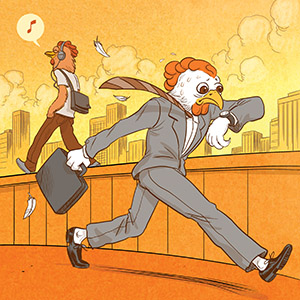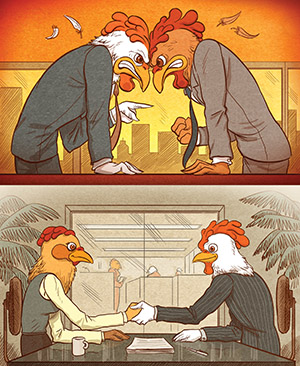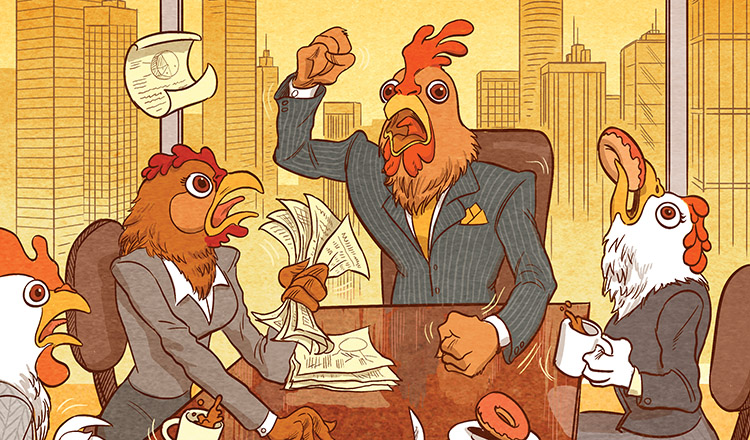Geneticist’s ‘superchicken’ research takes flight as metaphor for effective team management
William Muir (PhD A’77) gets a kick out of the attention, belated as it is.
More than 20 years after he published the findings of a fairly simple research project on egg production among two groups of hens, Muir has achieved a level of fame with an unexpected audience: those who study the productivity of humans at work.
He’s enjoying it, but that doesn’t make it any less surprising. “Human people,” he says with a chuckle, “don’t usually read animal literature.”
It’s a simple way of getting to the separation between academic branches, a line that Muir, a professor of animal sciences who specializes in breeding and genetics, has crossed in recent years through no effort of his own. It all goes back to that humble experiment, when Muir filled each of two cages with nine hens. The first cage housed what was essentially an “average” group of hens that had been collectively productive egg layers, while the other was loaded with the most prolific individual hens from different cages. And then he waited.
The smart money at the time was on the second group: If each of the individual hens in one cage was a prolific egg layer, it figured that their offspring would follow suit; that, generation by generation, their production would increase exponentially. It only took a few generations to disprove that conventional wisdom — and prove Muir’s hunch correct. Before long, six of the nine hens in the genetically superior group were dead, and the three remaining hens were pecked bare. This was “survival of the fittest” in action, Darwinian evolution at its most brutal — and, for a breeder relying on those eggs, a huge loss.
In the other cage, the nine “average” hens were getting along just fine, and their egg production increased with every generation. The lesson — that social dynamics might negate genetic advantages when so many hens share a cage — was obvious, and the findings, published in 1996 in the journal Poultry Science, led to an industry-wide change in breeding practices. Muir, mindful both of helping breeders and of the animal welfare benefits, knew he had something to be proud of.
It was a 2015 TED Talk by the management expert Margaret Heffernan that took Muir’s findings out of the henhouse and into the mainstream. Heffernan appears to be the first person outside of academia to try to apply the lessons of Muir’s research directly to the human workplace.
“For the past 50 years, we’ve run most organizations along the ‘superchicken’ model,” Heffernan said in her TED Talk. “We’ve thought that success is achieved by picking the superstars … and giving them all the resources and all the power. And the result has been just the same as in William Muir’s experiment: aggression, dysfunction, and waste.”
More than 2 million people have since watched Heffernan’s talk online, and dozens of articles have been written in business publications elaborating on how the behavior of hens in a cage can inform the best way to get people to work together. It’s hard to argue with the logic, and Muir believes the analogy holds up — with a few conditions. For starters, in coining the phrase that has helped make the research famous, Heffernan referred to the wrong group of hens. “It’s a misinterpretation that the individual chicken is super — like Superman — when in fact it’s the ‘super breed’ where everyone gets along,” Muir says.
Perhaps more important is an understanding of the limitations inherent in the comparison. Human beings have the benefit of social evolution, he says, allowing us to pass on concepts of how we should interact. “Our culture evolves by learning,” Muir says. “That’s where I constantly differentiate with people I talk to: I can only talk about this in the aspect of genetics. If we’re talking about animal breeding, I’m happy to talk about it. But I don’t think people should be going very far outside their area of expertise.”
With that in mind, we asked Purdue experts on human productivity to draw what conclusions they could: about how an emphasis on competitiveness over teamwork can be counterproductive — if not outright destructive — to group collaboration, productivity, and innovation. Their impressions echo what that second group of hens found out the hard way.
Dominant Achievers, Diminishing Returns
An assistant professor in the Krannert School of Management, Raquel Asencio Hodge sums up her research focus thusly: “I study teamwork.” She says the outcome of Muir’s experiment speaks to what has become conventional wisdom among those who study management issues — even if few formal studies have been dedicated to confirming it. She cites a 2010 study published in the journal Organization Science that covered similar ground, finding that “if you put too many really high-status people into a team, it looks like it’s going to be really successful, but in fact there are diminishing returns.”

A recent NASA-funded research project on the challenges faced by a manned mission to Mars sheds more light on the issue. In her work on the project, Asencio interviewed those working on the mission at NASA and at the European Space Agency. Of a potential Mars crew — astronauts and scientists selected from a highly competitive process — she says, “This is not just any kind of team. These are the best and brightest in their fields, going on a very long mission on a very small ship. And they have to work together.”
For astronauts living and working in tight quarters on a years-long mission, putting together the right team could be a matter of life and death. For the rest of us, the stakes probably aren’t quite as high. Nonetheless, says Brian Chupp, there is a growing awareness among managers that the makeup of a collaborative business team is one they have to take seriously. A lecturer in the Krannert School of Management, Chupp spent more than 20 years as a human resource manager and consultant, including stints with a pair of Fortune 500 companies. He tells his students what he’s told CEOs and managers for years: “You’ve got to have high performers, but recognize that performance means different things to different people. Not everyone has the same strengths.”
In Muir’s experiment, each hen had the same task: Lay as many eggs as you can. On human work teams, things are rarely so simple. Finding the right balance on any team means recognizing the strengths of its members. Chupp cites an example from his time at Home Depot, when a management change led to an influx of Type-A personalities. Initially, that decision paid off for the company, but Chupp says it eventually required an adjustment. “Taking a step back and looking at the bigger picture, it was clear that a lot of the work that was done to make these leaders successful was done by people who wouldn’t themselves be considered Type A.”
For Chupp, it was a reminder of the value of role players — the ones no team can win without.
Role Players Need Stars — and Vice Versa
In 2009, a much-discussed cover story in The New York Times Magazine explained how a move toward advanced analysis of player statistics had the potential to revolutionize basketball, leading to what its headline dubbed “the no-stats all-star.” The idea, says Asencio, was a player whose individual statistics didn’t imply much of an impact, “but when he’s on the court, his teammates simply do better. And when he’s off the court, they do worse.”
Chupp calls them “superstar role players,” those whose individual productivity — whether in number of projects completed or sales quotas surpassed — doesn’t impress, but who nonetheless make invaluable contributions to their team. The challenge is one that Muir’s test of egg production wasn’t designed to answer: How do you measure the contributions of team members whose individual production doesn’t stand out?
Asencio says her advice to managers is not to get caught up in bringing in the “smartest” candidate for every position. “It’s not always about that,” she says. Instead, she recommends looking for complementary traits: conscientiousness, agreeableness, team members who “seek communion and want to be liked.” Blended with higher achievers, those people tend to contribute to a smoother social dynamic, minimizing the risk of (figurative) henpecking that can be disastrous to a team’s overall goals.
Chupp recalls a story from his time with another company, which had just opened a state-of-the-art distribution center. “We’d brought in a lot of high-intensity, Type-A personalities, and it was working great,” he says. “Then around the holidays, we started bringing in hourly associates for extra help. And we decided to do some team building.” The project: A Christmas-tree decorating contest pitting the various departments against each other. Managers were excited to see how the new team members would embrace the chance to outdo each other. Instead, he says, “It fell flat on its face. The people out on the floor weren’t competitive like the managers were.”
For Chupp, it served to reinforce the importance of understanding motivation: While the stars on a given team tend to thrive on competition and crave external credit, those role players are generally happy to stay out of the spotlight, content with knowing they’ve quietly contributed to team success. Hens don’t have such noble thoughts, of course, but in an instinctive willingness to coexist, those in the healthy, productive, star-free group provide perhaps the best lesson for humans facing productivity challenges of our own.
Collaboration is Key
In a 2016 interview with the Evolution Institute, Muir elaborated on the idea of multi-level selection in his experiment — that consciously minimizing competition within the cage ultimately led to more overall production from the group. “This is exactly what is meant by ‘the whole is greater than the sum of the parts,’” Muir said. “As a group, we got out more than we put in.”

In applying the lessons to the human workplace, this is what resonates with Asencio. “That’s where having the best of the best on a single team is problematic, because collaboration suffers,” she says. “That’s the big takeaway I get from this study — that the whole is really greater than sum of its parts.”
“That’s where having the best of the best on a single team is problematic, because collaboration suffers. That’s the big takeaway I get from this study — that the whole is really greater than sum of its parts.”
Reflecting on it now, Muir remains pleasantly surprised to see his work embraced by experts in human management and organizational behavior. About once a month, he says, he’ll hear from researchers asking to see the original data, hoping to dig deeper on his interpretations, and curious whether he thinks that TED Talk got it right. He says the most unexpected inquiry came from a group of US military consultants, wondering if the superchicken model might be useful in training and organizing in the armed forces. (He argued that it might not be a good fit in an organization built around a strict chain of command, but could have applications within smaller teams.)
But for a researcher who has spent most of his career working with poultry, the knowledge that his work might help his fellow humans be happier and more productive at work has been its own reward.
“You hope to have a lasting impact, but you never know if you’re going to. So it’s been absolutely wonderful that this one concept has found its way not only into animal breeding, but also human anthropology,” he says. “I never thought that my research would actually ever find an application in human literature. I’m very gratified that they’ve seen it.”
Ryan Jones is a freelance writer based in Pennsylvania.

